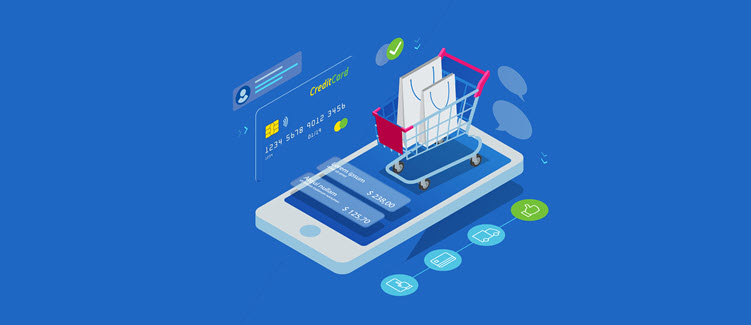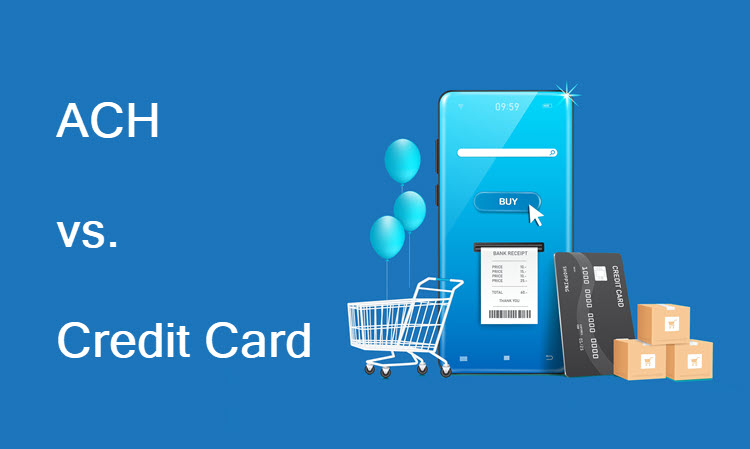ACH and credit card payments are two popular payment methods in the U.S. They are safe, fast to process, and allow customers to pay for goods and services, send funds to other accounts, or set up recurring payments.
ACH and credit card payments have their advantages and disadvantages, both for customers and businesses.
In this article, learn more about ACH and credit cards, their differences, and their best uses.
What Is an ACH Payment?
An ACH payment is a direct electronic money transfer from one U.S. bank account to another. ACH payments are processed in batches several times a day, thus driving down the cost of each transaction. ACH works very well for online payments, while most in-store businesses avoid working with ACH.
The ACH network processes two types of transactions:
- ACH direct deposit. ACH transfers made by organizations to an individual’s account (e.g., workers’ salaries and reimbursements, government benefits, tax refunds, etc.)
- ACH direct payment. ACH transfers made by organizations or individuals to other organizations or individuals (e.g., utility bills, mortgages, insurance payments, subscriptions, sending money to family and friends, etc.)
All ACH payments go through the Automated Clearing House (ACH) network, which brings together more than 10,000 financial institutions. ACH payments are cheap, fast, and secure but are geographically limited to the U.S.
Note: Learn more about the differences between ACH and Direct Deposit.
What Is a Credit Card Payment?

Credit and debit cards are the primary payment methods of shoppers and merchants worldwide.
Cardholders pay for a product or service by initiating and authorizing the transaction. Next, the issuing bank verifies and either approves or declines the payment request. If approved, the funds are reserved and then debited to the merchant’s bank account (the acquiring bank). Credit card transactions may be declined in case of insufficient funds, invalid payment data, or an expired credit card.
Payment card payments are globally available in-store via POS terminals and online via payment gateways.
ACH vs. Credit Card Payments
Here are the most notable differences between ACH and credit card payments:
Fees
ACH payments are much cheaper than credit card payments. The main reason for this is that ACH payments involve only three parties – the Nacha network, the originator (ODFI) and the receiver (RDFI). It is the participating financial institutions, the ODFI and the RDFI, that pay administrative fees.
On the other hand, credit card transactions involve multiple participants: credit card companies, issuing banks, acquiring banks, payment processors, and potentially other parties, all of which add their fees every time a payment is made. Most of the credit card processing fees are passed on to the merchant.
Note: ACH payments are usually cheaper, often even free, for consumers too.
Processing Times
The ACH network offers same-day, next-day and 2-day transactions. Hence, ACH processing times range from 1-3 business days.
How long it takes for a credit card payment to process varies, but most credit card payments are processed within 2 days.
Payment Guarantees
Payment guarantee is one of the major differences between ACH payments and credit cards.
When an ACH payment request is initiated, there is no guarantee the payment will be finalized. The recipient will only find out if the payment went through several days later when the process is completed. In the case of insufficient funds, incorrect account number or a closed account, the payment will not occur.
On the other hand, credit card payments are known as “guaranteed funds” transactions. The approval of credit card payments occurs almost instantly as the credit card network takes on the task of verifying the card limit. Once the network approves the transaction, the bank releases the funds, and the payee is guaranteed to receive the money.
Another point to remember is that authorized recurring ACH payments will not be interrupted if the account and the routing number stay the same. This contrasts with recurring payments made via credit card, which are suspended when the credit card expires, or the cardholder reports the card lost or stolen.
Chargebacks

A chargeback occurs when a customer disputes a payment made from their account. In the case of ACH payments, the reasons for disputing a charge are stricter than in the case of credit cards. The ACH network approves a payment reversal in the following cases:
- There was no authorization, or prior authorization was revoked.
- The payment was processed earlier than agreed upon.
- The payer was debited for an amount different than the authorized amount.
Customers wishing to dispute an ACH payment have 90 days to file a chargeback request.
Note: Learn everything you need to know about the differences between chargebacks and disputes.
On the other hand, banks will approve a credit card chargeback for many reasons, from receiving faulty goods to suspected fraud. Valid reasons for submitting a chargeback request for credit card payments include the following:
- Unauthorized payment.
- Goods or services not as described.
- Goods or services not received.
- Refund for returned goods not processed.
- Inaccurate amount charged.
- Recurring billing not stopped.
- Online payment fraud.
Cardholders have anywhere from 120 to 540 days to file a chargeback request on a credit card payment.
Note: The main purpose of chargebacks is to protect customers; however, some people have started abusing the system. Merchants suspecting chargeback abuse can challenge the decision in a process called representment.
Security

The ACH network guarantees payment safety by encrypting all sensitive information. However, the security of ACH payments is intrinsic to how the process works. The funds are transferred directly between accounts, and there are no physical objects (such as credit cards or paper checks) which can be lost, stolen, or tampered with.
On the other hand, credit card payments involve a variety of risks. Credit card information can be stolen online, while the credit card itself can be stolen or lost. To prevent credit card fraud in card-not-present transactions, banks and credit card companies have introduced a variety of tools, including:
- Strong customer authentication
- 3D Secure
- CVV/CVC security codes
PCI DSS are a set of regulations payment card brands mandate to safeguard sensitive payment information. Businesses that store credit card information must implement stringent security measures to remain PCI compliant.
Note: It can be very costly to become PCI compliant. That is why often the easiest way to ensure compliance is to partner with a reliable third-party payment processor.
Amount Limits
Financial institutions have transaction, daily, and monthly limits on ACH payments, which range from $2,000 a day to $25,000 a month. The daily limit imposed by NACHA (the body that oversees the ACH network) is $1,000,000 per transaction, whether incoming or outgoing.
Banks impose no universal daily or monthly limits for credit card payments. Limits on payments are set by the approved line of credit for the individual customer.
Geographical Limitations
The ACH network, which processes ACH payments, operates only in the United States. Other countries and regions have their own versions of this network (SEPA payments in Europe, for example).
Credit card payments are not limited to a single country or financial system. They are widely accepted across the globe. For global ecommerce, accepting credit card payments is a must.
ACH vs. Credit Cards: Which Payment Method to Offer?
Both ACH and credit cards are popular payment methods, and merchants should offer both options to their customers. That said, each payment method favors certain situations and business models.
When to Use ACH Payments?
ACH payments are suitable for paying out employees’ salaries and for long-term or recurring payments which require one-time authorization, such as:
- Bills. Monthly bills such as utilities, cell phone bills, car payments, etc.
- Subscriptions. Regular payments for video and music streaming services, SaaS subscriptions, gym memberships, etc. As a subscription business, accepting ACH payments will save you from failed transactions due to expired credit cards.
- Peer-to-peer payments. Sending money to family or friends from one bank account to another.
- Donations. Recurring donations to institutions and organizations.
When to Use Credit Cards?
Credit cards are suitable for payments that require fast authorization, large transfers, go cross-border. These include:
- Peer-to-peer payments. Credit cards offer an easy and convenient way to send money to friends and family.
- Large payments. Since they do not have daily or monthly limits, credit cards can be used to make high-value transfers.
- Online shopping. Credit cards are among the most common payment methods for online shopping. Some credit card networks even offer rewards such as cashback, airline miles, discounts on hotel stays, etc.
- Subscriptions. Credit cards are often used to pay for subscription services. The only downside is that a credit card expires and the consumer needs to remember to update their credit card information before it happens.
- International payments. Card networks recognize no national borders, so credit cards are the best way to make international payments.
Conclusion
ACH and credit cards are both widely popular methods for making online payments. They are secure, fast, and better alternatives to paper checks and wire transfers. Merchants wishing to increase their chances of customers finalizing a purchase should offer both options.
